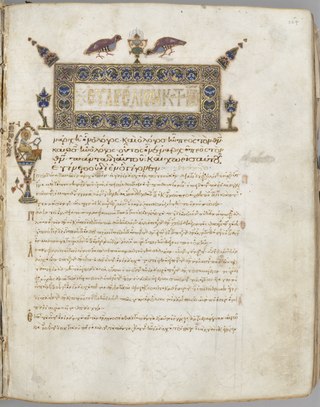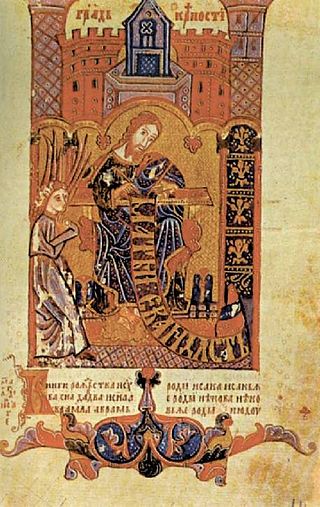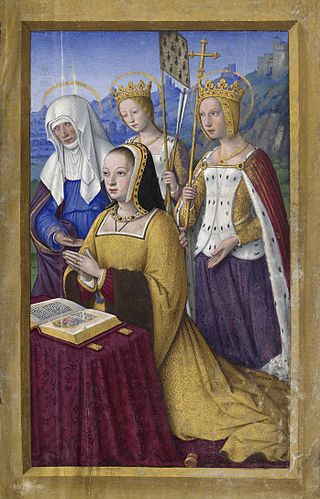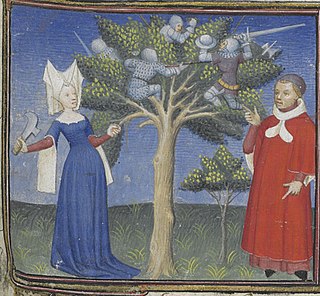Related Research Articles

Christine de Pizan or Pisan, was an Italian-born French poet and court writer for King Charles VI of France and several French dukes.

The Book of the City of Ladies, or Le Livre de la Cité des Dames, is a book written by Christine de Pizan believed to have been finished by 1405. Perhaps Pizan's most famous literary work, it is her second work of lengthy prose. Pizan uses the vernacular French language to compose the book, but she often uses Latin-style syntax and conventions within her French prose. The book serves as her formal response to Jean de Meun's popular Roman de la Rose. Pizan combats Meun's statements about women by creating an allegorical city of ladies. She defends women by collecting a wide array of famous women throughout history. These women are "housed" in the City of Ladies, which is actually the book. As Pizan builds her city, she uses each famous woman as a building block for not only the walls and houses of the city, but also as building blocks for her thesis. Each woman introduced to the city adds to Pizan's argument towards women as valued participants in society. She also advocates in favour of education for women.

An illuminated manuscript is a formally prepared document where the text is decorated with flourishes such as borders and miniature illustrations. Often used in the Roman Catholic Church for prayers and liturgical books such as psalters and courtly literature, the practice continued into secular texts from the 13th century onward and typically include proclamations, enrolled bills, laws, charters, inventories, and deeds.

The Limbourg brothers were Dutch miniature painters from the city of Nijmegen. They were active in the early 15th century in France and Burgundy, working in the International Gothic style.

The Très Riches Heures du Duc de Berry, or Très Riches Heures, is an illuminated manuscript that was created between c. 1412 and 1416. It is considered a book of hours, which is a type of Christian devotional book or a collection of prayers that was said at canonical hours. The manuscript was created for John, Duke of Berry, the brother of King Charles V of France, by Limbourg brothers Paul, Johan and Herman. The book is now MS 65 in the Musée Condé, Chantilly, France.

A miniature is a small illustration used to decorate an ancient or medieval illuminated manuscript; the simple illustrations of the early codices having been miniated or delineated with that pigment. The generally small scale of such medieval pictures has led to etymological confusion with minuteness and to its application to small paintings, especially portrait miniatures, which did however grow from the same tradition and at least initially used similar techniques.

Armenian illuminated manuscripts, form an Armenian tradition of formally prepared documents where the text is often supplemented with flourishes such as borders and miniature illustrations. They are related to other forms of Medieval Armenian art, Persian miniatures, and to Byzantine illuminated manuscripts. The earliest surviving examples date back to the Golden Age of Armenian art and literature in the 5th century. Armenian illuminated manuscripts embody Armenian culture; they illustrate its spiritual and cultural values.

Hval's Codex or Hval's Manuscript is a Bosnian Cyrillic manuscript of 353 pages written in 1404, in Split, for Duke Hrvoje Vukčić Hrvatinić. It was illuminated by Gothic artists from the Dalmatian littoral.

The Belles Heures of Jean de France, Duc de Berry, or Belles Heures of Jean de Berry is an early 15th-century illuminated manuscript book of hours commissioned by the French prince John, Duke of Berry, around 1409, and made for his use in private prayer and especially devotions to the Virgin Mary. The miniatures of the Belles Heures are mostly painted by the Limbourg brothers; very few books of hours are as richly decorated as it.

The Grandes Heures of Anne of Brittany is a book of hours, commissioned by Anne of Brittany, Queen of France to two kings in succession, and illuminated in Tours or perhaps Paris by Jean Bourdichon between 1503 and 1508. It has been described by John Harthan as "one of the most magnificent Books of Hours ever made", and is now in the Bibliothèque nationale de France, catalogued as Ms lat. 9474. It has 49 full-page miniatures in a Renaissance style, and more than 300 pages have large borders illustrated with a careful depiction of, usually, a single species of plant.

The Hours of Mary of Burgundy is a book of hours, a form of devotional book for lay-people, completed in Flanders around 1477, and now in the National Library of Austria. It was probably commissioned for Mary, the ruler of the Burgundian Netherlands and then the wealthiest woman in Europe. No records survive as to its commission. The book contains 187 folios, each measuring 225 by 150 millimetres. It consists of the Roman Liturgy of the Hours, 24 calendar roundels, 20 full-page miniatures and 16 quarter-page format illustrations. Its production began c. 1470, and includes miniatures by several artists, of which the foremost was the unidentified but influential illuminator known as the Master of Mary of Burgundy, who provides the book with its most meticulously detailed illustrations and borders. Other miniatures, considered of an older tradition, were contributed by Simon Marmion, Willem Vrelant and Lieven van Lathem. The majority of the calligraphy is attributed to Nicolas Spierinc, with whom the Master collaborated on other works and who may also have provided a number of illustrations.

The Ghent–Bruges school is a distinctive style of manuscript illumination which was prevalent in the Southern Netherlands from about 1475 to about 1550. Though the name highlights the importance of Ghent and Bruges as centres for manuscript production, manuscripts in the style were produced in a wider area.

The Treasure of the City of Ladies is a manual of education by medieval Italian-French author Christine de Pisan. Finished, like her previous The Book of the City of Ladies, by the year 1405, and dedicated to Margaret of Burgundy at a time when Christine was writing works for Margaret's father Duke John the Fearless of Burgundy, the book aims to educate women of all estates with advice on various topics. Her Book and Treasure are two of her best-known works, mainly due to the study of these books in modern academia.
Le livre du chemin de long estude is a first-person dream allegory by Christine de Pizan. Composed in 1402–03, it presents a critique of the moral state of the world and particularly France, lamenting the results of warfare.

A presentation miniature or dedication miniature is a miniature painting often found in illuminated manuscripts, in which the patron or donor is presented with a book, normally to be interpreted as the book containing the miniature itself. The miniature is thus symbolic, and presumably represents an event in the future. Usually it is found at the start of the volume, as a frontispiece before the main text, but may also be placed at the end, as in the Vivian Bible, or at the start of a particular text in a collection.

Le Ditie de Jehanne d'Arc is a patriotic lyrical verse, and the last work of the medieval French poet Christine de Pizan, who lived from 1364 to about 1430 AD. Earlier in her career Pizan wrote many texts including The Book of the City of Ladies which included tales about famous woman in history. Christine de Pizan was a professional poet in the court of King Charles VI of France. In her last work "The Tale of Joan of Arc" Pizan writes 61 verses about Joan of Arc, who led the French army to reclaim territory being held by the English. It was written before Joan lost in battle and was taken as a prisoner and right before the death of Christine de Pizan herself.

Mathilde Laigle (1865–1949) was a French historian. She was an early student in America becoming a governess to the children of the governor of Iowa. She was an expert on Christine de Pizan and is credited with helping to revive interest in the early feminist.
Charity Cannon Willard was an American scholar best known for drawing attention to the 15th-century poet and author Christine de Pizan in the English-speaking world. Willard translated and wrote critical editions of Pizan's work, and "is widely regarded as the world's preeminent scholar" on Christine de Pizan. Honoured with several academic awards, she is regarded by scholars as a trailblazer in the study of Pizan.

Le Livre de la mutation de fortune is a 1403 poem by Christine de Pizan. It is a universal history that tells the story of how Fortune has affected events. The frame narrative describes the process of the narrator's "transformation into a man" following the death of their husband, a metaphor used by the author expressing her adoption of the traditionally male social role of a court writer.

Gothic book illustration, or gothic illumination, originated in France and England around 1160/70, while Romanesque forms remained dominant in Germany until around 1300. Throughout the Gothic period, France remained the leading artistic nation, influencing the stylistic developments in book illustration. During the transition from the late Gothic period to the Renaissance, book illustration lost its status as one of the most important artistic genres in the second half of the 15th century, due to the widespread adoption of printing.
References
- 1 2 3 Davies, Penelope J.; et al. (2007). Janson's History of Art: The Western Tradition (7th ed.). Upper Saddle River: Pearson/Prentice Hall. ISBN 978-0131934689.
- ↑ Hindman, Sandra L. (1986). Christine de Pizan's "Epistre Othéa": Painting and Politics at the Court of Charles VI. Toronto: Pontifical Institute of Mediaeval Studies. p. 69. ISBN 978-0888440778.
- ↑ Miner, Dorothy Eugenia (1974). Anastaise and her Sisters: Women Artists of the Middle Ages. Baltimore: Walters Art Gallery. p. 21.
- ↑ Bell, Susan Groag (2004). The Lost Tapestries of the City of Ladies: Christine de Pizan's Renaissance Legacy. Berkeley: University of California Press. p. 154. ISBN 978-0520234109.